| Mercury in the Laboratory | ||

Introduction and Background
With proper controls and training, elemental mercury can be safely used in a laboratory setting. However, when spilled or misused it can present a significant hazard. See the following stories for some recent chilling (and expensive) examples:
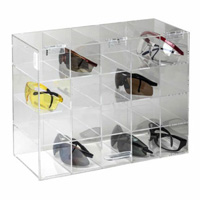
Make your PPE readily available with safety dispensers from Safety Emporium.
- As difficult as it can be to believe, someone opened a day care center in a building that formerly housed a mercury thermometer factory. The building was eventually demolished and disposed of as hazardous waste (Franklinville, NJ, 2006-2010).
- Agua Fria High School was contaminated with approximately five pounds of mercury stolen from an unsecured storage area. Cleanup costs were ~$800,000. Six homes had moderate levels of mercury contamination, and three of them required extensive remediation. (Avondale, AZ, February 2010).
- Kids playing with mercury contaminated several homes, Rosemount MN, September 2004.
- "Teen unaware of mercury risk", Las Vegas, January 2004.
- Mercury Spill Incidents from the NY State Department of Health lists over 9 case studies over a five year period.
- 11 pounds of stolen mercury led to contamination across West Houston in 2019.
- A mercury spill at a North Texas mail distribution center closed the facility for a week. Another closed a post office in Marcellus, NY for two weeks. It is illegal to mail liquid mercury.
- A private school in Virginia Beach discovered mercury that contaminated the school building and caused up to $130,000 USD in cleanup costs.
Therefore, minimize your use of mercury and mercury compounds whenever possible.
According to the MIT Department of Health and Safety's Safety Note dated October 6, 1989:
The element mercury is a liquid metal with a vapor pressure of 0.00185 mm at 25 degrees C. This corresponds to a saturation concentration in air of 20 milligrams of mercury per cubic meter of air or 2.4 ppm . The American Conference of Governmental Industrial Hygienists has established a threshold limit for mercury vapor of 0.05 milligrams of Hg per cubic meter of air for continuous 40 hour per week exposure. Long term chronic exposure to mercury vapor in excess of 0.05 mg Hg per cubic meter of air may result in cumulative poisoning. The use of mercury in laboratory amounts in well-ventilated areas is fairly safe; however, mercury can present a health hazard under the following circumstances:
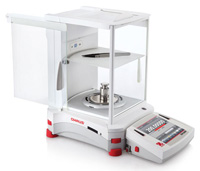
Laboratory operations are a breeze with Ohaus analytical balances from Safety Emporium.
- When a mercury spill is not cleaned up promptly it may be ground into the floor, fracturing into extremely small particles with a large total surface area (6.4 square feet for 1 ml as 10 micron spheres). From such large areas mercury may vaporize at a rate faster than the room's ventilation can safely dilute it.
- The rate of mercury volatilization is directly related to temperature. Whenever elevated temperatures are involved special care must be exercised to provide adequate ventilation. A common occurrence is the breaking of thermometers in ovens due to bumping or raising the oven above the thermometer's capacity.
- The impact of mercury at high velocities or its release into high air velocity systems will atomize mercury into extremely small particle sizes and large surface area. This generally results from inadequate connections in pressure systems.
- Mercury is often dumped into drains. These drains may eventually leak and a workman using a torch to free the joints may, as the result of another's carelessness, receive an overexposure. [Such releases are also a violation of EPA regulations].
Mercury compounds can be quite dangerous. A professor at Dartmouth University (an experienced researcher and expert on the toxicology of heavy metal poisoning) died in 1997 after spilling just a few drops of dimethylmercury on her latex gloves.

Working With Mercury in the Laboratory
Whenever you perform any action with mercury it will spill and splash. It inevitably forms tiny beads that cling to many surfaces and roll several feet away. Large drops quickly break up into thousands of small ones as described above.
Mercury can be handled safely by a professional chemist, although you should minimize or eliminate its use whenever possible. Here are some prudent practices when using mercury:
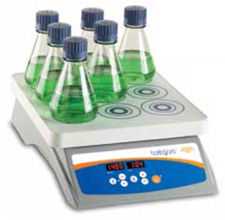
Safety Emporium has all kinds of lab equipment such as stirring hot plates.
- Find an alternative to using mercury in the first place:
- Use alcohol or digital thermometers instead of mercury ones.
- Use oil bubblers instead of mercury bubblers when possible.
- Consider using reducing agents other than mercury amalgams in your laboratory procedures.
- NEVER use a mercury thermometer in a laboratory oven. If it breaks in a hot oven, you have not only the obvious health concern, but also a HazMat response situation. Your lab will have to be shut down, probably for several days, for cleaning and testing. The oven will have to be disposed of as hazardous waste. A break in a cold oven is an equally serious situation.
- Do not leave open containers of mercury in the laboratory. If used in a bubbler, the exhaust should go up a vertical tube to eliminate splashing and should be vented to a fume hood.
- Do not keep excess mercury around if you do not need it. We've seen dozens of research groups that have collected or accumulated tens or hundreds of pounds of mercury over the years - amounts that they could clearly never use. In the event of spill, accident, or fire, the release of this much mercury would be a major catastrophe.
- Clean up spills promptly. When handling mercury use a glass, plastic or steel tray to contain any spills that might occur. Caution: mercury amalgamates with many common metals such as aluminum, so choose your container carefully.
- Glass or plastic vessels should have a secondary steel or plastic container around them in case the vessel fails.
- Do not use mercury where it could contact a hot surface and vaporize.
- Avoid inhaling mercury vapor and use suitable gloves when working with it.
- Put mercury waste in a special waste container. Do not combine it with "regular" organic or inorganic wastes. NEVER dispose of it down the sink!
- Do not wear gold or silver jewelry when working with mercury; it will amalgamate and irreversibly damage your jewelry!
- Although not a safety issue, mercury is very expensive to dispose of as waste.
- Take appropriate measures in the event of a spill (see link #3 below). Sprinkling elemental sulfur on spilled mercury is virtually ineffective; the reaction between Hg and S is not appreciable at room temperature. Amalgamation with fresh zinc dust works fairly well for "soaking up" those noisome tiny beads of mercury once the bulk of the spill has been collected manually.
- Read the Safety Data Sheet (SDS) for mercury before using it. As indicated on the SDS, mercury is dangerously incompatible with aluminum, ammonia, chlorates, copper, copper alloys, ethylene oxide, halogens, iron, nitrates, sulfur, sulfuric acid, oxygen, acetylene, lithium, rubidium, sodium carbide, lead, nitromethane, peroxyformic acid, calcium, chlorine dioxide, metal oxides, azides, 3-bromopropyne, alkynes + silver perchlorate, methylsilane + oxygen, tetracarbonylnickel + oxygen and boron diiodophosphide.
- As with most other chemicals in your laboratory, access to mercury should be restricted to a locked cabinet or room. Do not leave mercury where a passerby or unauthorized person can swipe it (see the examples in the articles mentioned above).
- If you continue to use mercury-containing apparatus such as MacLeod gauges, sphygmomanometers, bubblers etc. consider protecting them to prevent accidental breakage or leakage. See, for example, Safety Enclosure for Mercury Filled McLeod Gauge, J Chem Ed 1970, 47, 755 (paywalled).
The cost of cleaning up a thermometer break in a laboratory oven far exceeds that of a new laboratory oven with a built-in digital temperature display and fail-safe mechanism.

Recycling Mercury in the Laboratory
Those who use mercury know that clean mercury has a wonderfully shiny surface. But over time, the mercury in your bubbler or diffusion pump tends to get dirty and contaminated, usually with a floating film of gray/black sludge. While you certainly need to clean your apparatus, you can easily recover most of the mercury for reuse rather than replacing it. This saves on disposal costs and reduces the amount of mercury you need to use.
The "best" cleanup method in a chemical sense would be distillation However, boiling mercury and then cleaning up the distillation apparatus afterward is not appealing for a number of obvious reasons. Luckily, there are two easier methods that work quite well for most needs. Before using either of these, set up a large steel or plastic spill tray in a fume hood! Do not try this on the bench because you will spill some mercury.

Clean mercury has a mirror-like surface like the one on this 8 mm bead. The lens of the camera says "Carl Zeiss". Photo by Rob Toreki.
- The syringe technique. Get a 10 mL syringe with needle. Stick the needle below the surface of the contaminated mercury and withdraw clean mercury. Hold onto the syringe with both hands when you withdraw it, keeping the syringe vertical and holding the plunger to prevent/reduce mercury from dribbling back out. Transfer the mercury to your recovery vessel (which should be only an inch or two away).
- The filter paper technique. Fold a filter paper into quarters and then rip a tiny hole in the bottom of the cone. Place the paper in a glass or plastic funnel with the stem of the funnel as close to the bottom of your collection vessel as possible (to minimize splashing). Slowly pour your contaminated mercury into the filter. Most of the sludge will remain behind on the filter paper. You may need to refilter one or more times.
These cleanup methods work because the sludge is insoluble and less dense than mercury. If your mercury is contaminated with a metal that has amalgamated such as sodium, you may be able to remove the metal chemically, for example, by quenching the sodium metal using established procedures. If the metal is not easily or safely removable through such chemical means, then proper disposal (rather than dealing with distillation) is your best option.
Small amounts of mercury residues left behind on contaminated glassware can be removed (dissolved) with a dilute nitric acid solution. Be sure not to pour the acid waste down the sink. Collect the used acid solution a waste container that is used only for mercury-contaminated nitric acid waste and dispose of it properly.

Risks and Environmental Impact
Remember, inhalation is the primary danger from mercury, especially if there is not good ventilation. In fact, some scientists believe that vapor inhalation from dental amalgams can cause Alzheimer's disease in certain genetically predisposed individuals, although the safety of dental amalgams is still a topic of hot debate. Brief, one-time exposures on the skin (from handling mercury) or even ingestion (it has been used as a laxative) are not likely to produce significant health effects in most cases, but don't test your luck. Chronic (long-term) exposure of any sort can lead to all sorts of nasty effects including permanent central nervous system damage, fatigue, weight loss, tremors, personality changes and death.
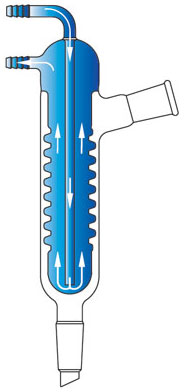
Chill out with laboratory condensers from Safety Emporium.
Because of the ease with which mercury is spilled, the difficulty of ensuring complete cleanup, the curiousity factor of a room temperature liquid metal, and the known health risks, we recommend that mercury use in high school and freshman-level college courses be discontinued entirely. This includes both mercury-containing compounds as well as equipment such as thermometers. In fact, the Centers for Disease Controls' MMWR reported on November 7, 2008 that the ATSDR found that mercury was the most common chemical released in school chemical incidents in the period 2002-2007.
Laboratory concerns aside, we'd like to see the use of mercury in dental amalgams discontinued regardless of whether there is a health risk to the patient. The exposure of the dental technicians, mercury waste discharge to the sewer during dental procedures, discharge of mercury during cremation etc. all present serious environmental and health hazards. See, for example, "Characterization of Methyl Mercury in Dental Wastewater and Correlation with Sulfate-Reducing Bacterial DNA" Environ. Sci. Technol. 2008, 42(8), 2780-2786. As of 2022, the EU is actively considering legislation which will phase out dental amalgams, a process that began in 2017 with the banning of amalgam use in children under 15 years of age and pregnant or breastfeeding women.
We also strongly support the banning of mercury in consumer products such as thermometers, thermostats, batteries, lighting, and motion switches. There are equally good or better alternatives that do not present a risk of personal or environmental contamination. The use of mercury-containing fluorescent lighting, particularly compact fluorescent lighting (CFL's) meant for household use, has been the source of considerable debate. While CFL's provide significant energy savings, thankfully, the declining cost and superior performance of modern LED lighting should make this concern moot in the near future.
The United States has recently taken some very good steps towards limiting mercury environmental contamination. For example, the Mercury Export Ban Act of 2008 banned the export of metallic mercury effective 2013, a move meant to discourage the wanton misuse of mercury in gold mining operations in developing nations. The act also requires the US Department of Energy to designate and manage an elemental mercury long-term disposal facility, although it appears as of 2022 this is an unfulfilled quest. Likewise, the European Parliament enacted an export ban effective in 2011 that also covers mercury compounds (this was superseded by more comprehensive legislation in 2017). And the Minamata Convention on Mercury should further reduce the use and emission of mercury and mercury-containing products.
The Obama administration scored a victory in reducing the rather significant power plant emissions of mercury and other toxins when Bush-era mercury emissions trading regulations were overturned in favor of strict emissions caps designed to drastically reduce atmospheric emissions from coal-fired power plants. By an agreement reached in late October of 2009, the US EPA would regulate emissions of mercury (and other hazardous air pollutants emitted from coal and oil-fired power plants) starting December 16, 2011. Alas, in 2018, the Trump administration announced plans to roll back the rules as too costly, despite industry having already complied and having no actual objection to keeping them. In 2022, the Biden administration announced it would reinstate the weakened rules, rules which have proven societal and environmental benefits.

Further Resources
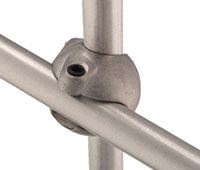
Bring it all together with laboratory lattice frames and connectors from Safety Emporium.
- ATSDR has devoted a section of their web site to Mercury and Your Health. See also their ToxFAQ for Mercury and guidance for releases and spills for mercury.
- The NY State Department of Health has some good resources titled Reducing Mercury in Schools: Science Teachers.
- UNL has a page briefly detailing how to handle small metallic mercury spills in the laboratory.
- The US EPA's Inventory Of Mercury Supply, Use, And Trade In The United States 2020 Report.
- The US Department of Energy's 2011 Long-Term Management and Storage of Elemental Mercury Environmental Impact Statement
- The US EPA's Mercury Export Ban Act of 2008.
- The Mercury Policy Project is devoted to eliminating mercury use and reducing mercury exposure.
